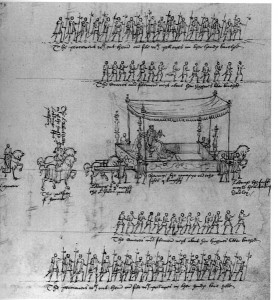 On this day in history, 14th January 1559, at 3pm, Elizabeth I left the Tower for her eve of coronation procession in a cloth of gold litter carried by two mules. As she passed the Tower of London menagerie, Elizabeth prayed to God, thanking him for her deliverance, like that of Daniel from the lion’s den.
On this day in history, 14th January 1559, at 3pm, Elizabeth I left the Tower for her eve of coronation procession in a cloth of gold litter carried by two mules. As she passed the Tower of London menagerie, Elizabeth prayed to God, thanking him for her deliverance, like that of Daniel from the lion’s den.
Elizabeth was a natural. She charmed the crowd, smiling warmly at people, joking and replying to their good wishes.
It was usual for pageants to be part of a coronation procession, and Elizabeth had five:
- Gracechurch Street – This pageant referred to Elizabeth’s genealogy, her Tudor roots and the history of the House of Tudor. The people were reminded that her name sake and grandmother Elizabeth of York had brought peace to the land by marrying Henry Tudor and uniting the warring Houses of York and Lancaster. Elizabeth, too, would bring peace and unity to the land.
- Cornhill – This pageant referred to Elizabeth’s new government as being upheld by four virtues: True Religion, Love of Subjects, Wisdom and Justice.
- Soper’s Lane – This pageant was based on the New Testament Beatitudes and, as Starkey explains, applied them to Elizabeth’s sufferings at the hands of her sister.
- Little Conduit, Cheapside – This pageant with its subject of “Time” attacked Mary’s reign, contrasting “a decayed commonwealth” to “a flourishing commonwealth” in two tableaux. Time’s daughter, Truth, carried an English Bible labelled the “Word of Truth”, which Elizabeth’s government was said to possess. When Elizabeth saw this pageant, she asked for the Bible and “kissed it, and with both her hands held up the same, and so laid it on her breast, with great thanks to the City therefore.”
- Fleet Street – This pageant depicted Elizabeth as the prophetess Deborah who had rescued Israel from Jabin, King of Canaan. Like Deborah, Elizabeth would reign over her people for over forty years.
The procession ended at Westminster in readiness for Elizabeth’s coronation ceremony the next day in Westminster Abbey.
Extract taken from On This Day in Tudor History by Claire Ridgway.